Energy Flux Paths in Lakes and Reservoirs
Abstract
:1. Introduction
2. Materials and Methods
2.1. Study Sites and Measurements
2.2. Energy Content
2.2.1. Internal Waves
2.2.2. Surface Waves
2.2.3. Schmidt Stability
2.3. Energy Fluxes
2.3.1. Wind Energy Flux and Rate of Working
2.3.2. Surface Wave Energy Flux
2.3.3. Surface Heat Flux and Buoyancy Flux
2.3.4. Energy Flux to Basin-Scale Internal Waves
2.4. Dissipation Rates
3. Results
3.1. Overview of the Measurements
3.2. Wind Energy Flux and Rate of Working
3.3. Surface Waves
3.4. Internal Waves
3.5. Dissipation Rate in Surface and Bottom Boundary Layers
4. Discussion
4.1. Overall Energy Budget
4.2. Energy Transfer Efficiency
4.3. Surface and Internal Waves
4.4. Energy Dissipation Rates
4.5. Study Limitations
5. Conclusions
Supplementary Materials
Author Contributions
Funding
Institutional Review Board Statement
Informed Consent Statement
Data Availability Statement
Acknowledgments
Conflicts of Interest
References
- Imberger, J. Flux paths in a stratified lake: A review. In Physical Processes in Lakes and Oceans; American Geophysical Union: District of Columbia, WA, USA, 1998; pp. 1–17. [Google Scholar]
- Jähne, B.; Haußecker, H. Air-Water Gas Exchange. Annu. Rev. Fluid Mech. 1998, 30, 443–468. [Google Scholar] [CrossRef]
- Perolo, P.; Fernández Castro, B.; Escoffier, N.; Lambert, T.; Bouffard, D.; Perga, M.-E. Accounting for Surface Waves Improves Gas Flux Estimation at High Wind Speed in a Large Lake. In Dynamics of the Earth System; Interactions: Franklin, MA, USA, 2021. [Google Scholar]
- MacIntyre, S. Vertical Mixing in a Shallow, Eutrophic Lake: Possible Consequences for the Light Climate of Phytoplankton. Limnol. Oceanogr. 1993, 38, 798–817. [Google Scholar] [CrossRef]
- Huisman, J.; Sharples, J.; Stroom, J.M.; Visser, P.M.; Kardinaal, W.E.A.; Verspagen, J.M.H.; Sommeijer, B. Changes in Turbulent Mixing Shift Competition for Light between Phytoplankton Species. Ecology 2004, 85, 2960–2970. [Google Scholar] [CrossRef] [Green Version]
- Peeters, F.; Straile, D.; Lorke, A.; Ollinger, D. Turbulent Mixing and Phytoplankton Spring Bloom Development in a Deep Lake. Limnol. Oceanogr. 2007, 52, 286–298. [Google Scholar] [CrossRef]
- Corman, J.R.; McIntyre, P.B.; Kuboja, B.; Mbemba, W.; Fink, D.; Wheeler, C.W.; Gans, C.; Michel, E.; Flecker, A.S. Upwelling Couples Chemical and Biological Dynamics across the Littoral and Pelagic Zones of Lake Tanganyika, East Africa. Limnol. Oceanogr. 2010, 55, 214–224. [Google Scholar] [CrossRef] [Green Version]
- Bocaniov, S.A.; Schiff, S.L.; Smith, R.E.H. Plankton Metabolism and Physical Forcing in a Productive Embayment of a Large Oligotrophic Lake: Insights from Stable Oxygen Isotopes: Plankton Metabolism and Physical Forcing. Freshw. Biol. 2012, 57, 481–496. [Google Scholar] [CrossRef]
- MacIntyre, S.; Jellison, R. Nutrient Fluxes from Upwelling and Enhanced Turbulence at the Top of the Pycnocline in Mono Lake, California. Hydrobiologia 2001, 466, 13–29. [Google Scholar] [CrossRef]
- Sepúlveda Steiner, O. Mixing Processes and Their Ecological Implications: From Vertical to Lateral Variability in Stratified Lakes; EPFL: Lausanne, Switzerland, 2020. [Google Scholar]
- Lorke, A.; Müller, B.; Maerki, M.; Wüest, A. Breathing Sediments: The Control of Diffusive Transport across the Sediment-Water Interface by Periodic Boundary-Layer Turbulence. Limnol. Oceanogr. 2003, 48, 2077–2085. [Google Scholar] [CrossRef]
- Sobek, S.; Durisch-Kaiser, E.; Zurbrügg, R.; Wongfun, N.; Wessels, M.; Pasche, N.; Wehrli, B. Organic Carbon Burial Efficiency in Lake Sediments Controlled by Oxygen Exposure Time and Sediment Source. Limnol. Oceanogr. 2009, 54, 2243–2254. [Google Scholar] [CrossRef] [Green Version]
- Søndergaard, M.; Jensen, J.P.; Jeppesen, E. Role of Sediment and Internal Loading of Phosphorus in Shallow Lakes. Hydrobiologia 2003, 506–509, 135–145. [Google Scholar] [CrossRef]
- Wüest, A.; Piepke, G.; Van Senden, D.C. Turbulent Kinetic Energy Balance as a Tool for Estimating Vertical Diffusivity in Wind-Forced Stratified Waters. Limnol. Oceanogr. 2000, 45, 1388–1400. [Google Scholar] [CrossRef]
- Imboden, D.M. The Motion of Lake Waters. In The Lakes Handbook, Volume 1; O’Sullivan, P.E., Reynolds, C.S., Eds.; Blackwell Science Ltd.: Malden, MA, USA, 2003; pp. 115–152. ISBN 978-0-470-99927-1. [Google Scholar]
- Woolway, R.I.; Simpson, J.H. Energy Input and Dissipation in a Temperate Lake during the Spring Transition. Ocean Dyn. 2017, 67, 959–971. [Google Scholar] [CrossRef]
- Simpson, J.H.; Woolway, R.I.; Scannell, B.; Austin, M.J.; Powell, B.; Maberly, S.C. The Annual Cycle of Energy Input, Modal Excitation and Physical Plus Biogenic Turbulent Dissipation in a Temperate Lake. Water Res. 2021, 57, e2020WR029441. [Google Scholar] [CrossRef]
- Simon, A. Turbulent Mixing in the Surface Boundary Layer of Lakes. Ph.D. Thesis, Swiss Federal Institute of Technology, Zürich, Switzerland, 1997. [Google Scholar]
- Heyna, B.; Groen, P. On Short-Period Internal Gravity Waves. Physica 1958, 24, 383–389. [Google Scholar] [CrossRef]
- Boegman, L.; Ivey, G.N.; Imberger, J. The Energetics of Large-Scale Internal Wave Degeneration in Lakes. J. Fluid Mech. 2005, 531, 159–180. [Google Scholar] [CrossRef] [Green Version]
- Preusse, M.; Peeters, F.; Lorke, A. Internal Waves and the Generation of Turbulence in the Thermocline of a Large Lake. Limnol. Oceanogr. 2010, 55, 2353–2365. [Google Scholar] [CrossRef] [Green Version]
- Downing, J.A.; Prairie, Y.T.; Cole, J.J.; Duarte, C.M.; Tranvik, L.J.; Striegl, R.G.; McDowell, W.H.; Kortelainen, P.; Caraco, N.F.; Melack, J.M.; et al. The Global Abundance and Size Distribution of Lakes, Ponds, and Impoundments. Limnol. Oceanogr. 2006, 51, 2388–2397. [Google Scholar] [CrossRef] [Green Version]
- Choulga, M.; Kourzeneva, E.; Zakharova, E.; Doganovsky, A. Estimation of the Mean Depth of Boreal Lakes for Use in Numerical Weather Prediction and Climate Modelling. Tellus A Dyn. Meteorol. Oceanogr. 2014, 66, 21295. [Google Scholar] [CrossRef] [Green Version]
- Rinke, K.; Hübner, I.; Petzoldt, T.; Rolinski, S.; König-Rinke, M.; Post, J.; Lorke, A.; Benndorf, J. How Internal Waves Influence the Vertical Distribution of Zooplankton. Freshw. Biol. 2007, 52, 137–144. [Google Scholar] [CrossRef] [Green Version]
- Poff, N.L.; Hart, D.D. How Dams Vary and Why It Matters for the Emerging Science of Dam Removal. BioScience 2002, 52, 659. [Google Scholar] [CrossRef] [Green Version]
- Tundisi, J.G. Limnology; CRC Press: Boca Raton, FL, USA, 2017; ISBN 978-1-138-07204-6. [Google Scholar]
- Kerimoglu, O.; Rinke, K. Stratification Dynamics in a Shallow Reservoir under Different Hydro-Meteorological Scenarios and Operational Strategies. Water Resour. Res. 2013, 49, 7518–7527. [Google Scholar] [CrossRef]
- Wagner, A.H.; Janssen, M.; Kahl, U.; Mehner, T.; Benndorf, J. Initiation of the Midsummer Decline of Daphnia as Related to Predation, Non-Consumptive Mortality and Recruitment: A Balance. Arch. Hydrobiol. 2004, 160, 1–23. [Google Scholar] [CrossRef]
- Casper, S.J. Lake Stechlin: A Temperate Oligotrophic Lake; Springer: Berlin/Heidelberg, Germany, 2012; Volume 58. [Google Scholar]
- Goring, D.G.; Nikora, V.I. Despiking Acoustic Doppler Velocimeter Data. J. Hydraul. Eng. 2002, 128, 117–126. [Google Scholar] [CrossRef] [Green Version]
- Wahl, T.L. Discussion of “Despiking Acoustic Doppler Velocimeter Data” by Derek G. Goring and Vladimir I. Nikora. J. Hydraul. Eng. 2003, 129, 484–487. [Google Scholar] [CrossRef] [Green Version]
- Münnich, M.; Wüest, A.; Imboden, D.M. Observations of the Second Vertical Mode of the Internal Seiche in an Alpine Lake. Limnol. Oceanogr. 1992, 37, 1705–1719. [Google Scholar] [CrossRef]
- De Carvalho Bueno, R.; Bleninger, T.; Lorke, A. Internal Wave Analyzer for Thermally Stratified Lakes. Environ. Model. Softw. 2021, 136, 104950. [Google Scholar] [CrossRef]
- Antenucci, J.P.; Imberger, J. On Internal Waves near the High-Frequency Limit in an Enclosed Basin. J. Geophys. Res. 2001, 106, 22465–22474. [Google Scholar] [CrossRef]
- Chen, C.-T.A.; Millero, F.J. Thermodynamic Properties for Natural Waters Covering Only the Limnological Range. Limnol. Oceanogr. 1986, 31, 657–662. [Google Scholar] [CrossRef]
- Kundu, P.K.; Cohen, I.M.; Dowling, D.R. Gravity Waves. In Fluid Mechanics; Elsevier: Amsterdam, The Netherlands, 2012; pp. 253–307. ISBN 978-0-12-382100-3. [Google Scholar]
- Holliday, D.; Mcintyre, M.E. On Potential Energy Density in an Incompressible, Stratified Fluid. J. Fluid Mech. 1981, 107, 221. [Google Scholar] [CrossRef]
- Kang, D.; Fringer, O. On the Calculation of Available Potential Energy in Internal Wave Fields. J. Phys. Oceanogr. 2010, 40, 2539–2545. [Google Scholar] [CrossRef]
- Read, J.S.; Hamilton, D.P.; Jones, I.D.; Muraoka, K.; Winslow, L.A.; Kroiss, R.; Wu, C.H.; Gaiser, E. Derivation of Lake Mixing and Stratification Indices from High-Resolution Lake Buoy Data. Environ. Model. Softw. 2011, 26, 1325–1336. [Google Scholar] [CrossRef]
- RBR Ltd. Wave Parameters. Available online: https://docs.rbr-global.com/support/ruskin/ruskin-features/waves/wave-parameters (accessed on 25 July 2021).
- Ruskin Software. Available online: https://rbr-global.com/products/software (accessed on 25 July 2021).
- Imboden, D.M.; Wüest, A. Mixing Mechanisms in Lakes. In Physics and Chemistry of Lakes; Lerman, A., Imboden, D.M., Gat, J.R., Eds.; Springer: Berlin/Heidelberg, Germany, 1995; pp. 83–138. ISBN 978-3-642-85134-6. [Google Scholar]
- Foken, T.; Nappo, C.J. Micrometeorology; Springer: Berlin/Heidelberg, Germany, 2008; ISBN 978-3-540-74665-2. [Google Scholar]
- Paulson, C.A. The Mathematical Representation of Wind Speed and Temperature Profiles in the Unstable Atmospheric Surface Layer. J. Appl. Meteorol. Climatol. 1970, 9, 857–861. [Google Scholar] [CrossRef]
- Large, W.G.; Pond, S. Open Ocean Momentum Flux Measurements in Moderate to Strong Winds. J. Phys. Oceanogr. 1981, 11, 324–336. [Google Scholar] [CrossRef] [Green Version]
- Hofmann, H.; Lorke, A.; Peeters, F. The Relative Importance of Wind and Ship Waves in the Littoral Zone of a Large Lake. Limnol. Oceanogr. 2008, 53, 368–380. [Google Scholar] [CrossRef]
- Bluteau, C.E.; Jones, N.L.; Ivey, G.N. Estimating Turbulent Kinetic Energy Dissipation Using the Inertial Subrange Method in Environmental Flows: TKE Dissipation in Environmental Flows. Limnol. Oceanogr. Methods 2011, 9, 302–321. [Google Scholar] [CrossRef]
- Wiles, P.J.; Rippeth, T.P.; Simpson, J.H.; Hendricks, P.J. A Novel Technique for Measuring the Rate of Turbulent Dissipation in the Marine Environment. Geophys. Res. Lett. 2006, 33, L21608. [Google Scholar] [CrossRef]
- Guerra, M.; Thomson, J. Turbulence Measurements from Five-Beam Acoustic Doppler Current Profilers. J. Atmos. Ocean. Technol. 2017, 34, 1267–1284. [Google Scholar] [CrossRef]
- McMillan, J.M.; Hay, A.E. Spectral and Structure Function Estimates of Turbulence Dissipation Rates in a High-Flow Tidal Channel Using Broadband ADCPs. J. Atmos. Ocean. Technol. 2017, 34, 5–20. [Google Scholar] [CrossRef]
- Lorke, A. Boundary Mixing in the Thermocline of a Large Lake. J. Geophys. Res. 2007, 112, C09019. [Google Scholar] [CrossRef] [Green Version]
- Jabbari, A.; Rouhi, A.; Boegman, L. Evaluation of the Structure Function Method to Compute Turbulent Dissipation within Boundary Layers Using Numerical Simulations. J. Geophys. Res. Oceans 2016, 121, 5888–5897. [Google Scholar] [CrossRef]
- Lorke, A.; Wüest, A. Application of Coherent ADCP for Turbulence Measurements in the Bottom Boundary Layer. J. Atmos. Ocean. Technol. 2005, 22, 1821–1828. [Google Scholar] [CrossRef] [Green Version]
- Guseva, S.; Aurela, M.; Cortes, A.; Kivi, R.; Lotsari, E.S.; Macintyre, S.; Mammarella, I.; Ojala, A.; Stepanenko, V.M.; Uotila, P.; et al. Variable Physical Drivers of Near-Surface Turbulence in a Regulated River. Water Resour. Res. 2021, 57. [Google Scholar] [CrossRef]
- Scannell, B.D.; Rippeth, T.P.; Simpson, J.H.; Polton, J.A.; Hopkins, J.E. Correcting Surface Wave Bias in Structure Function Estimates of Turbulent Kinetic Energy Dissipation Rate. J. Atmos. Ocean. Technol. 2017, 34, 2257–2273. [Google Scholar] [CrossRef]
- Lorke, A.; MacIntyre, S. The Benthic Boundary Layer (in Rivers, Lakes, and Reservoirs). In Encyclopedia of Inland Waters; Elsevier: Amsterdam, The Netherlands, 2009; pp. 505–514. ISBN 978-0-12-370626-3. [Google Scholar]
- Benndorf, J.; Kranich, J.; Mehner, T.; Wagner, A. Temperature Impact on the Midsummer Decline of Daphnia galeata: An Analysis of Long-Term Data from the Biomanipulated Bautzen Reservoir (Germany): Temperature Impact on Midsummer Decline. Freshw. Biol. 2001, 46, 199–211. [Google Scholar] [CrossRef]
- Hasselmann, K.F.; Barnett, T.; Bouws, E.; Carlson, H.; Cartwright, D.; Enke, K.; Ewing, J.; Gienapp, H.; Hasselmann, D.; Meerburg, A.; et al. Measurements of Wind-Wave Growth and Swell Decay during the Joint North Sea Wave Project (JONSWAP). Ergänzungsheft zur Dtsch. Hydrogr. Z. Reihe A 1973, 12, 1–95. Available online: http://hdl.handle.net/21.11116/0000-0007-DD3C-E (accessed on 14 October 2021).
- Mortimer, C.H.; McNaught, D.C.; Stewart, K.M. Short Internal Waves near Their High-Frequency Limit in Central Lake Michigan. In Proceedings of the 11th Annual Conference on Great Lakes Research, Milwaukee, WI, USA, 18–20 April 1968; pp. 454–469. [Google Scholar]
- Thorpe, S.A. High-Frequency Internal Waves in Lake Geneva. Phil. Trans. R. Soc. Lond. A 1996, 354, 237–257. [Google Scholar] [CrossRef]
- Stevens, C.L. Internal Waves in a Small Reservoir. J. Geophys. Res. 1999, 104, 15777–15788. [Google Scholar] [CrossRef]
- Gímez-Giraldo, A.; Imberger, J.; Antenucci, J.P.; Yeates, P.S. Wind-Shear-Generated High-Frequency Internal Waves as Precursors to Mixing in a Stratified Lake. Limnol. Oceanogr. 2008, 53, 354–367. [Google Scholar] [CrossRef]
- Ishikawa, M.; Bleninger, T.; Lorke, A. Hydrodynamics and Mixing Mechanisms in a Subtropical Reservoir. Inland Waters 2021, 11, 286–301. [Google Scholar] [CrossRef]
- Fricker, P.D.; Nepf, H.M. Bathymetry, Stratification, and Internal Seiche Structure. J. Geophys. Res. 2000, 105, 14237–14251. [Google Scholar] [CrossRef]
- Lorke, A.; McGinnis, D.F.; Spaak, P.; Wuest, A. Acoustic Observations of Zooplankton in Lakes Using a Doppler Current Profiler. Freshw. Biol. 2004, 49, 1280–1292. [Google Scholar] [CrossRef]
- Lorke, A.; Weber, A.; Hofmann, H.; Peeters, F. Opposing Diel Migration of Fish and Zooplankton in the Littoral Zone of a Large Lake. Hydrobiologia 2008, 600, 139–146. [Google Scholar] [CrossRef] [Green Version]
- Lorke, A.; Probst, W.N. In Situ Measurements of Turbulence in Fish Shoals. Limnol. Oceanogr. 2010, 55, 354–364. [Google Scholar] [CrossRef]
- Kunze, E. Biologically Generated Mixing in the Ocean. Annu. Rev. Mar. Sci. 2019, 11, 215–226. [Google Scholar] [CrossRef]
- Simoncelli, S.; Thackeray, S.J.; Wain, D.J. Can Small Zooplankton Mix Lakes? Limnol. Oceanogr. 2017, 2, 167–176. [Google Scholar] [CrossRef]
- Wickramarathna, L.N.; Noss, C.; Lorke, A. Hydrodynamic Trails Produced by Daphnia: Size and Energetics. PLoS ONE 2014, 9, e92383. [Google Scholar] [CrossRef] [PubMed]
- Nowlin, W.H.; Davies, J.-M.; Nordin, R.N.; Mazumder, A. Effects of Water Level Fluctuation and Short-Term Climate Variation on Thermal and Stratification Regimes of a British Columbia Reservoir and Lake. Lake Reserv. Manag. 2004, 20, 91–109. [Google Scholar] [CrossRef]
- Bonnet, M.-P.; Poulin, M.; Devaux, J. Numerical Modeling of Thermal Stratification in a Lake Reservoir. Methodology and Case Study. Aquat. Sci. 2000, 62, 105. [Google Scholar] [CrossRef]
- Jabbari, A.; Boegman, L.; Valipour, R.; Wain, D.; Bouffard, D. Dissipation of Turbulent Kinetic Energy in the Oscillating Bottom Boundary Layer of a Large Shallow Lake. J. Atmos. Ocean. Technol. 2020, 37, 517–531. [Google Scholar] [CrossRef]
- Sachs, T.; Wille, C. FLUXNET-CH4 DE-Dgw Dagowsee, Dataset, 2015–2018. Available online: https://doi.org/10.18140/FLX/1669633 (accessed on 20 August 2021).
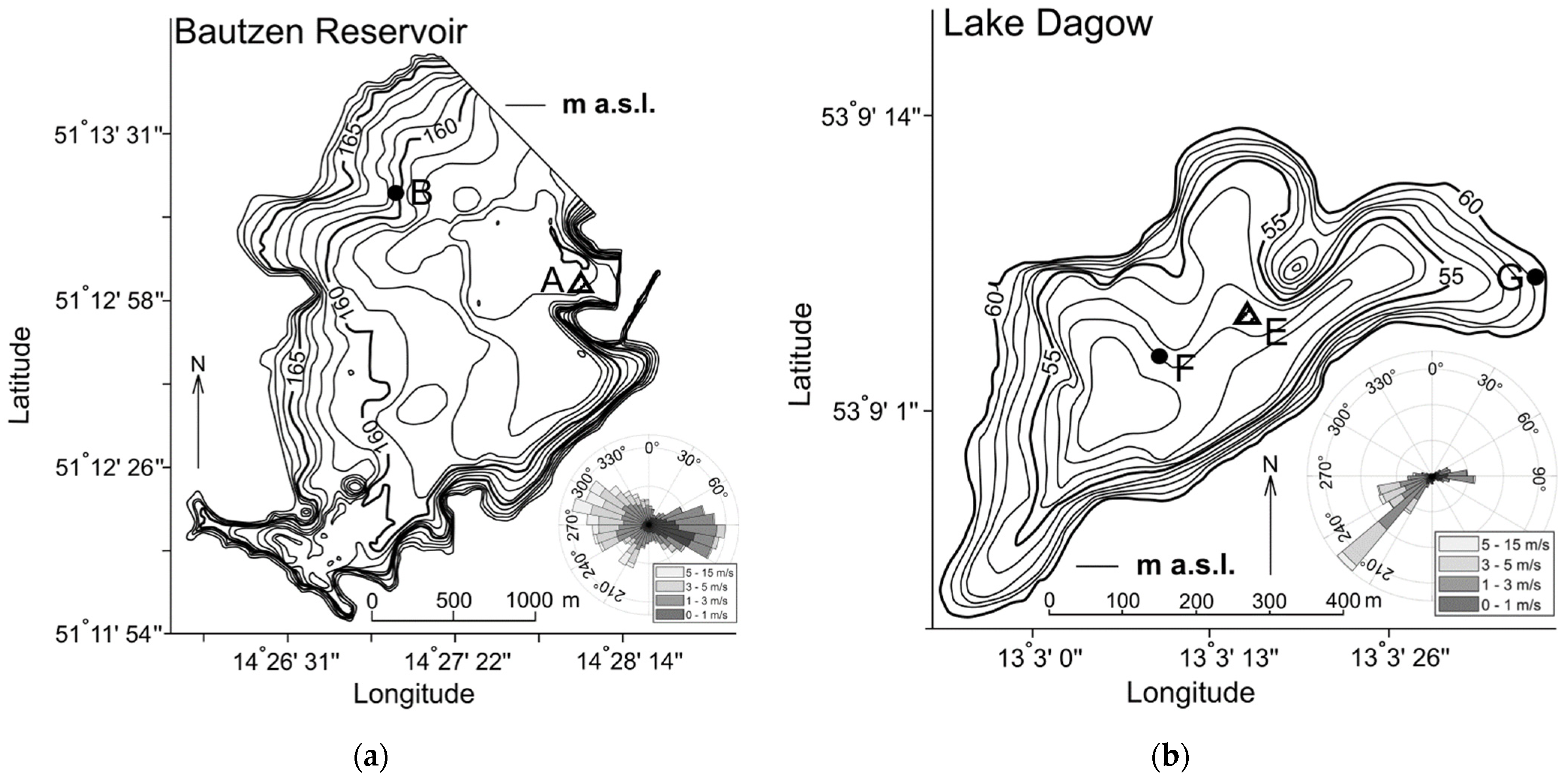
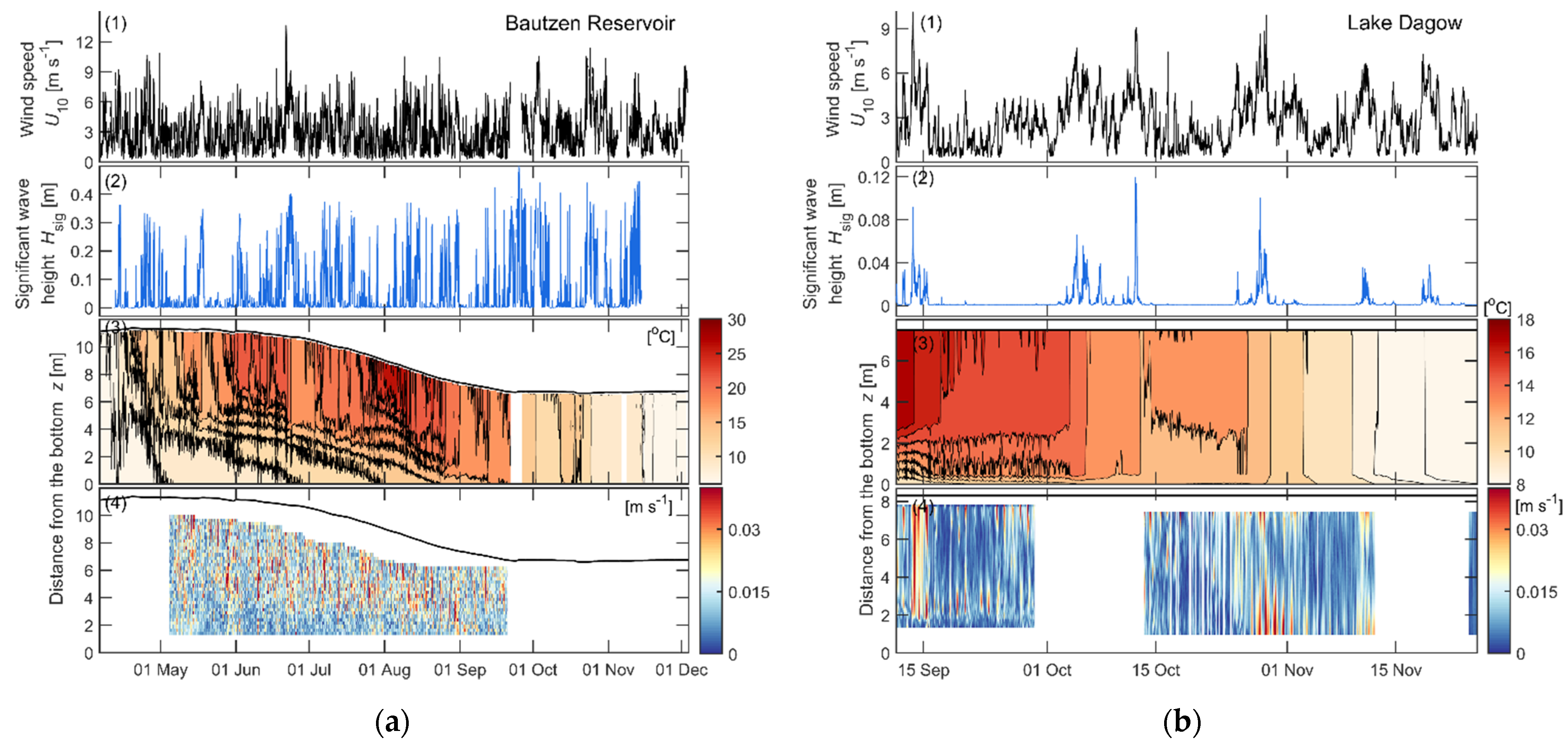

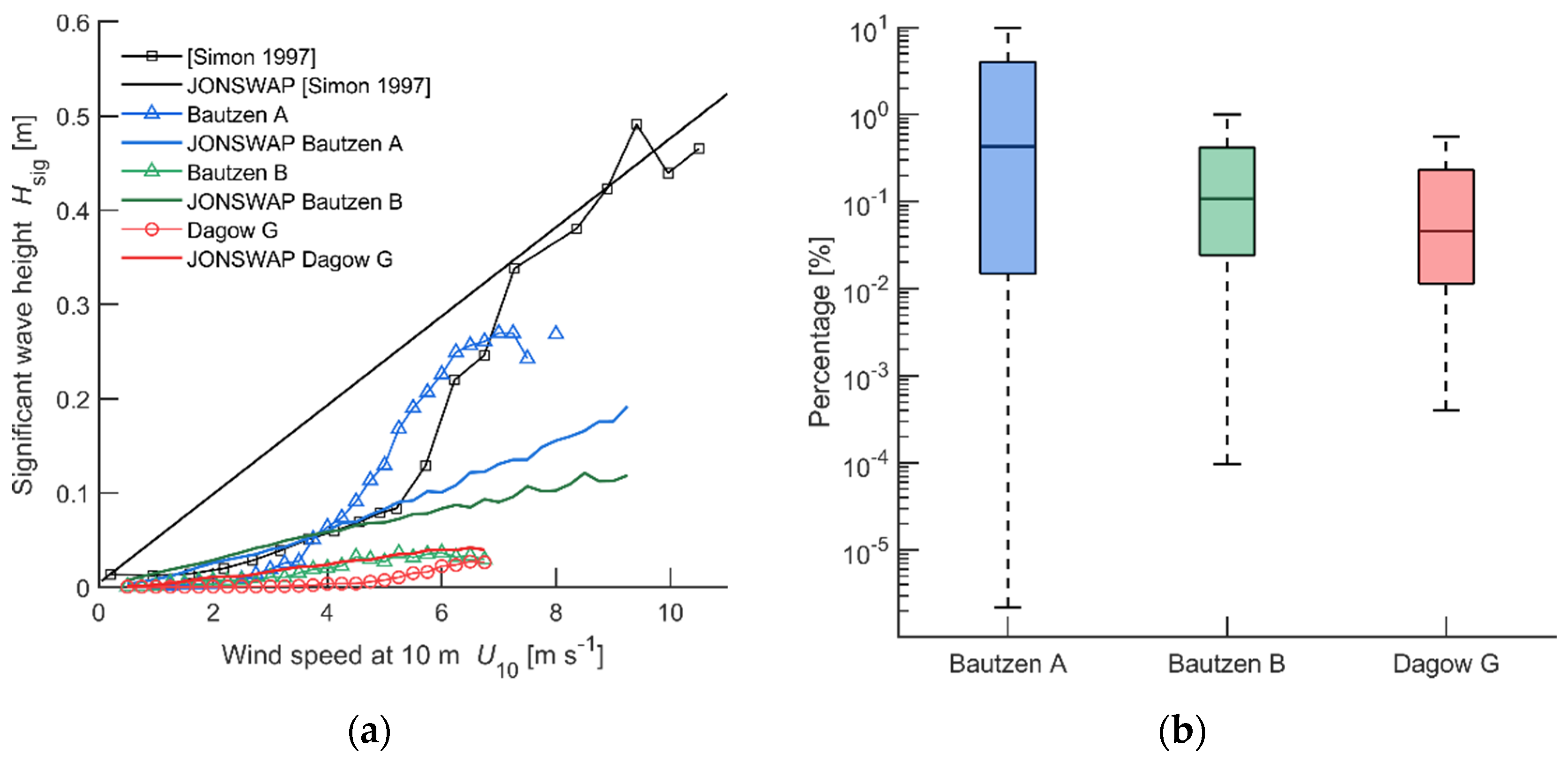
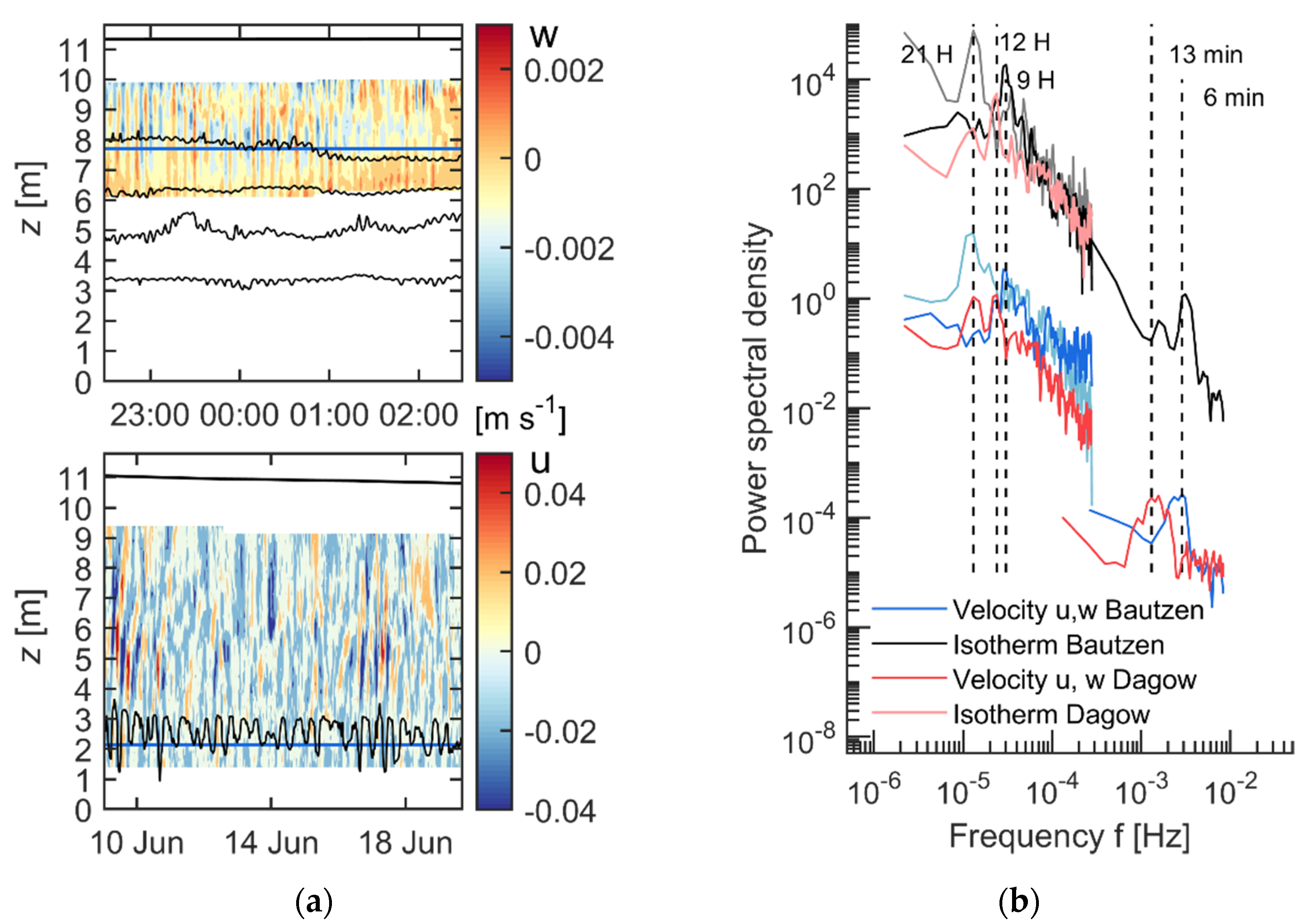
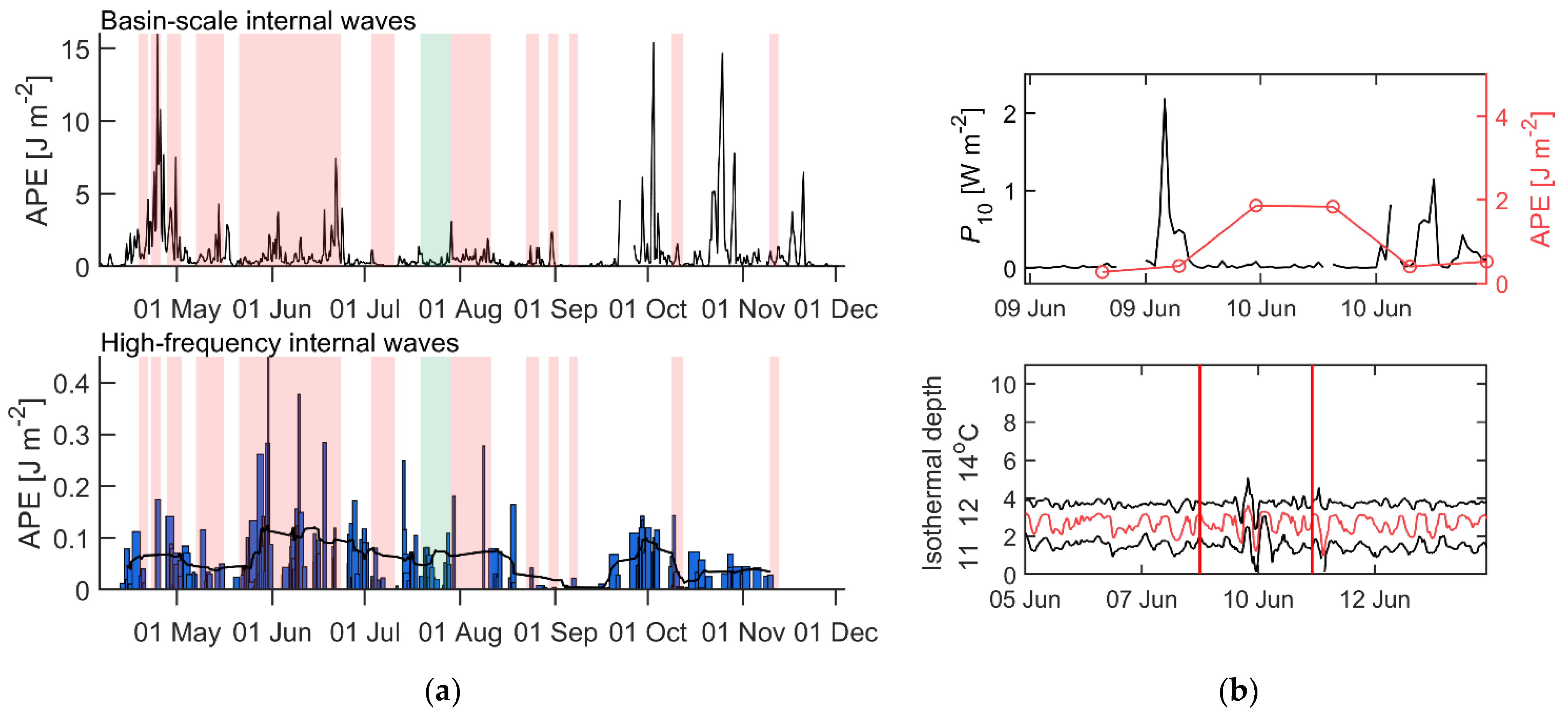
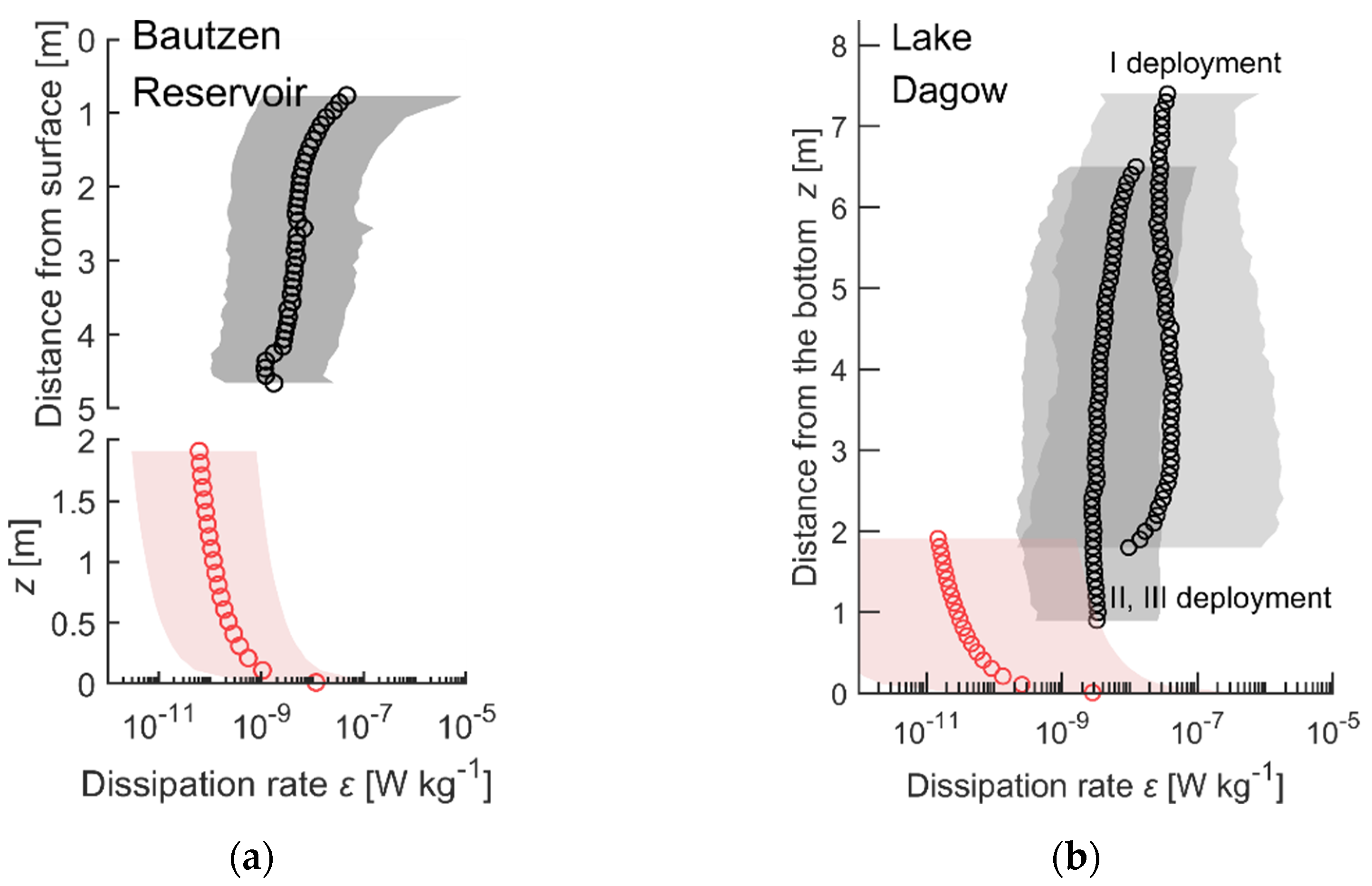
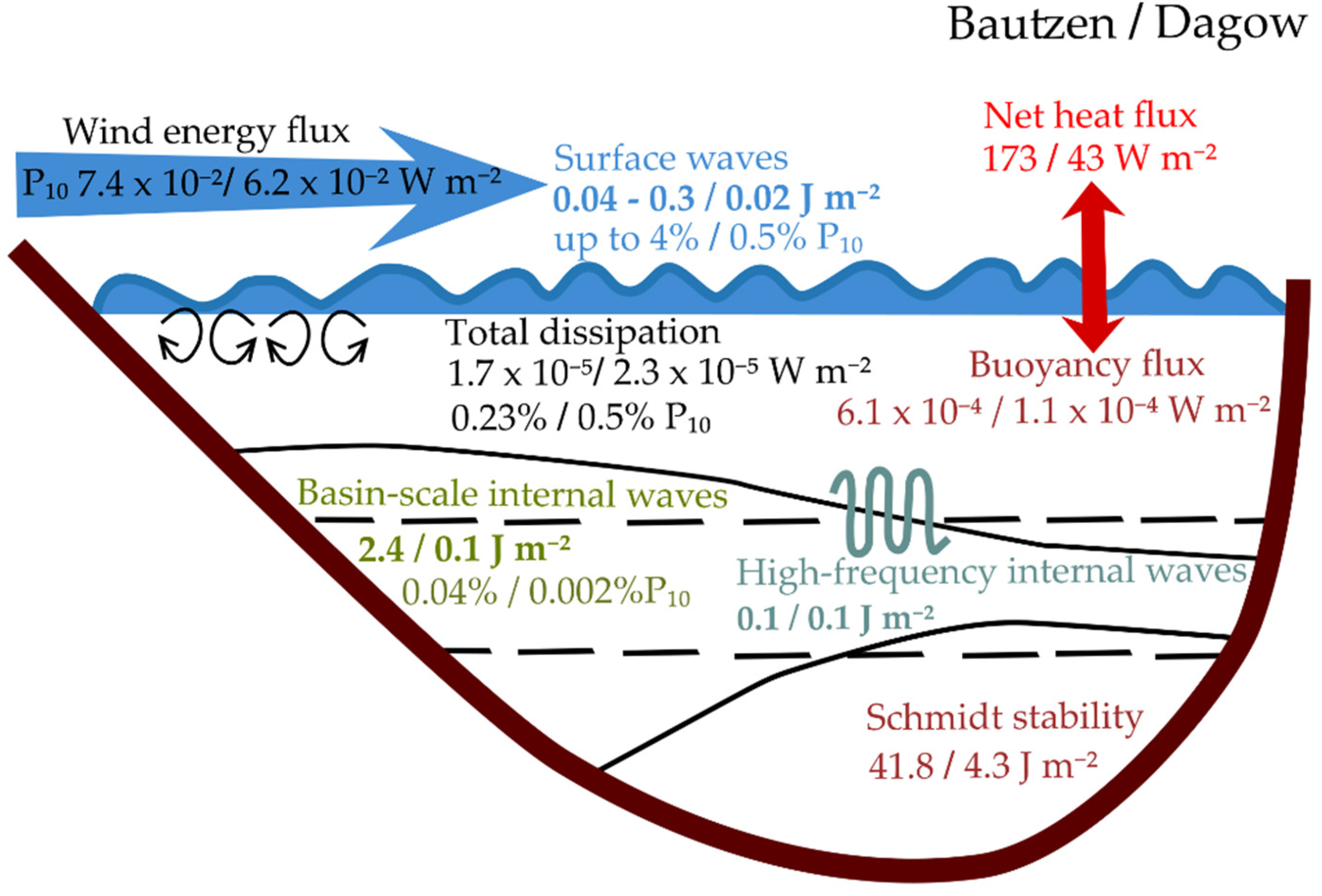
| Type of Measurements | Water Body | Instrument | Resolution | Location on the Map (Figure 1) |
|---|---|---|---|---|
| Flow velocity | Bautzen Reservoir | (a) ADCP RDI Workhorse 600 kHz (range: 1.4–10 m); (b) Workhorse 1200 kHz (range: 0.8–4.7 m) | (a) 10 min with 200 pings with 0.25 m bin size; (b) 1 s with 0.1 m bin size | (a) Bottom deployment (facing upward) ~10 m from southern corner of the platform; (b) platform deployment (facing down, southwest corner) |
| Lake Dagow | ADCP RDI Workhorse 600 kHz (3 deployments, range: (1) 0.5–6.8 m; (2–3) 0.8–7.1 m) | 5 s with 12 pings with 0.1 m bin size | 3 deployments: (1) platform (facing down, west corner), point E; (2–3) ~6–7 m from northern corner of the platform (facing upward) | |
| Water temperature | Bautzen Reservoir | (a) Thermocouples (type T, Copper/Constantan) | 10 min averages from measurements in 30 s intervals | Platform, point A |
| Lake Dagow | RBR solo | 10 s | Point F | |
| Wave measurements | Bautzen Reservoir | RBR duet | 10 min with 512 measurements of 16 Hz | Platform, point A; shore, point B |
| Lake Dagow | Shore, point G | |||
| Wind speed | Bautzen Reservoir | Campbell Scientific, CSAT3 (1.8 m) | 20 Hz, as well as 10 min and 30 min averages | Platform, point A |
| Lake Dagow | Gill Instruments HS-50 (1.97 m) | 20 Hz | Platform, point E | |
| Radiation | Bautzen Reservoir | Kipp and Zonen, CNR1 | 10 and 30 min averages from measurements in 30 s intervals | Platform, point A |
| Lake Dagow | Kipp and Zonen, CNR4 | measured at 1 Hz, logged at 1 min averages | Platform, point E |
Publisher’s Note: MDPI stays neutral with regard to jurisdictional claims in published maps and institutional affiliations. |
© 2021 by the authors. Licensee MDPI, Basel, Switzerland. This article is an open access article distributed under the terms and conditions of the Creative Commons Attribution (CC BY) license (https://creativecommons.org/licenses/by/4.0/).
Share and Cite
Guseva, S.; Casper, P.; Sachs, T.; Spank, U.; Lorke, A. Energy Flux Paths in Lakes and Reservoirs. Water 2021, 13, 3270. https://doi.org/10.3390/w13223270
Guseva S, Casper P, Sachs T, Spank U, Lorke A. Energy Flux Paths in Lakes and Reservoirs. Water. 2021; 13(22):3270. https://doi.org/10.3390/w13223270
Chicago/Turabian StyleGuseva, Sofya, Peter Casper, Torsten Sachs, Uwe Spank, and Andreas Lorke. 2021. "Energy Flux Paths in Lakes and Reservoirs" Water 13, no. 22: 3270. https://doi.org/10.3390/w13223270






